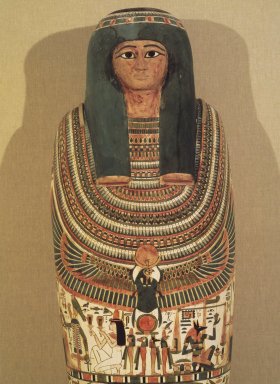Lady Gautseshenu goes to the Hospital
Yesterday, a team of curators, conservators, and art packers and handlers took the last of our human mummies to North Shore University Hospital to be CT scanned. (See Lisa Bruno and Ed Bleiberg’s blogs about the previous mummies).

Inner Cartonnage of Gautseshenu, 700-650 B.C.E. Linen, plaster, pigment, 64 3/16 x 14 15/16 in. (163 x 38 cm). Brooklyn Museum, Charles Edwin Wilbour Fund, 34.1223.
Lady Gautseshenu, who dates from around 700-650 b.c.e, was a descendent of a prominent priestly family and entered the Brooklyn Museum collection in 1934. The mummy itself is sealed in a beautifully painted cartonnage that has never been opened. The object had been x-rayed in the past, and from those results we could tell that there was an intact female body within the cartonnage. The opportunity to CT scan her and discuss the results with the team at North Shore University Hospital gives us additional insight. We were happy to work with the same group of doctors and technicians as our previous visit, namely Drs. Amgad Makaryus, Jesse Chusid, John O’Donnell, and Karen Lisk. Some of the questions we hoped to answer – How old is she? Are there any signs of trauma? Do any internal organs remain? Were there any unusual items buried with her? What about her physical condition might tell us something about how she lived?

CT Scanning of Inner Cartonnage of Gautseshenu at North Shore University Hospital
While more detailed analysis of the CT scans is on-going, a preliminary review reveals that she is an adult female, with some signs of osteoarthritis in the pelvis and backbone. Dr. Chusid and his colleagues say that this might not necessarily mean that she was old – this could have been a condition that affects younger (adult) women as well. The scans also show that her brain had been completely removed. This was typically done through the nose, and this was confirmed on the scans by the fact that there was significant damage to her nasal septum. As would also be expected, an incision was found on the left side of the abdomen. This is where the internal organs would have been removed. Her heart was left in place during the embalming process, which, according to our curator Ed Bleiberg, would have been done in higher quality mummifications. In turn, it appears that her lungs may also have been left in place, something that is much more unusual. While there were no signs of trauma to her body, two of her ribs are cracked, though this probably happened post mortem. Inside the chest area and inside near the incision, there appear to be a few amulets. Further manipulation of the scans is needed to clarify which amulets these might be. Our curators were also curious to know if there were differences in the mummification process between males and females. We saw a few interesting things in the CT scans regarding that – once we do a little more research, we’ll let you know!
Please check back with us as we continue to work with North Shore University Hospital to interpret the data. Lady Gautseshenu will go back on display in the Mummy Chamber during the first week of May and you can check out more photos of her visit to the hospital on Flickr.

Tina March is an assistant conservator of objects at the Brooklyn Museum where she has been since receiving her M.A. in Conservation from Buffalo State College in 2001. She has a B.A. in Art Conservation from the University of Delaware. Previous internships include The Art Institute of Chicago, the Guggenheim Museum and The National Museum of the American Indian.
